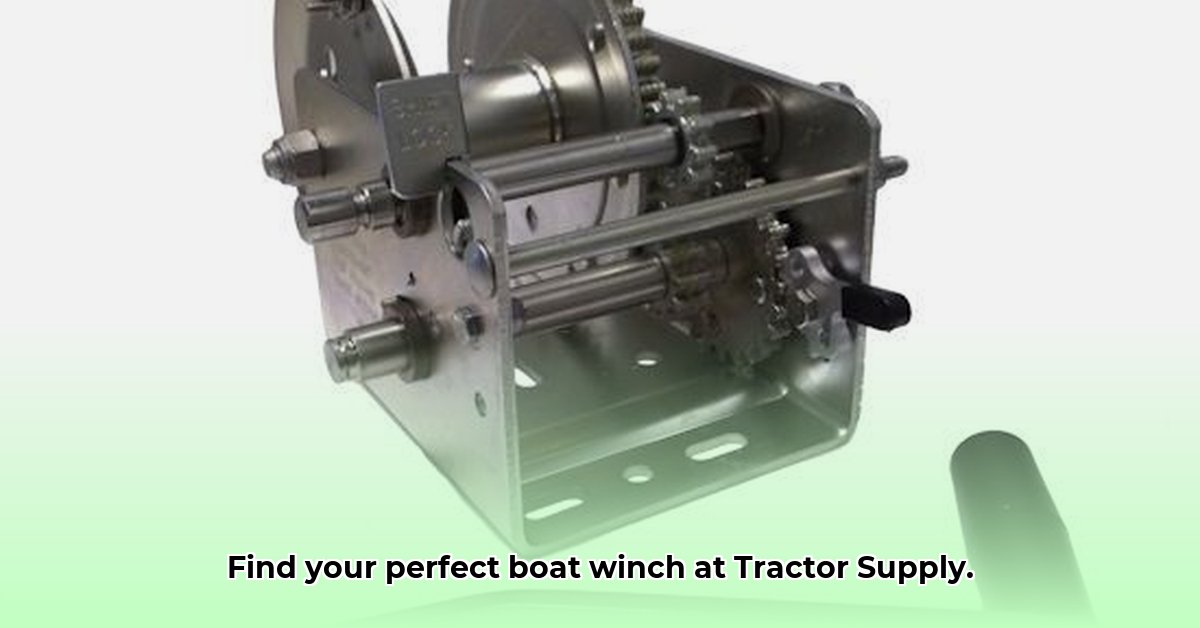
This comprehensive guide helps you navigate the world of boat winches, from selection to maintenance. We'll focus on Tractor Supply's offerings, providing practical advice for both novice and experienced boaters. Whether you need a winch for anchoring, sailing, or other on-water tasks, this guide will equip you to make an informed decision and ensure safe, efficient operation.
Selecting the Right Boat Winch
Choosing the right boat winch is critical for safety and efficiency. Several factors influence this choice: boat size, intended use, and budget. Larger boats require winches with higher load capacities. The intended use (e.g., anchoring, hauling sail) also dictates the required strength and features.
Winch Types:
- Manual Winches: These are generally less expensive and require no electrical power. They are ideal for smaller boats and lighter loads. However, they demand more physical effort.
- Electric Winches: Offering greater convenience and power, electric winches are perfect for heavier loads and larger vessels. However, they require a power source and are more expensive.
- Self-Tailing Winches: These winches automatically hold the rope under load, reducing strain and making operation easier. This feature adds to the cost.
Factors to Consider:
- Boat Size: Match the winch's weight capacity to your boat's size and the anticipated loads. Underestimating capacity is dangerous.
- Intended Use: Different applications demand varying features. For instance, a winch for anchoring might need a higher holding power than one used for sail handling.
- Budget: Winch prices vary significantly depending on features, capacity, and type. Set a budget beforehand to avoid impulse purchases.
- Tractor Supply's Selection: Tractor Supply carries a range of winches, often at competitive prices. However, it's advisable to compare their offerings with other retailers before making a decision.
Installing Your Boat Winch: A Step-by-Step Guide
Correct installation is paramount for safety and winch longevity. Follow these steps precisely:
Preparation: Thoroughly clean and inspect the chosen mounting location on your boat's deck. Ensure the chosen spot is strong enough to support the winch's maximum load and any additional stress from pulling.
Mounting: Using the included mounting hardware, securely attach the winch base to the deck. Ensure all bolts are correctly tightened according to the manufacturer's instructions. Avoid over-tightening, as this can cause damage.
Cable Routing: Guide the cable from the winch to the designated point on your boat (e.g., anchor point). Avoid sharp bends or kinks that could weaken the cable. Maintain sufficient slack to prevent unnecessary strain on the winch mechanism.
Testing: Before full use, perform a test run with a moderate load. This ensures correct functionality and familiarizes you with the winch operation. Address any issues identified during the test immediately.
Safety Precautions: Always wear appropriate gloves when working with the winch cable and avoid wrapping fingers around it while it's moving. Never exceed the winch's rated capacity. This is non-negotiable for preventing injury and damage.
Boat Winch Maintenance and Troubleshooting
Regular maintenance is vital for preventing costly repairs and ensuring the winch's continued functionality.
Cleaning: Regularly clean the winch with fresh water, removing salt, dirt, and debris. Allow it to dry completely before storage.
Lubrication: Apply a suitable marine-grade lubricant to moving parts as recommended in the manufacturer's instructions. This reduces friction and prevents corrosion.
Cable Inspection: Frequently inspect the cable for any signs of wear, fraying, or damage. Replace the cable promptly if any issues are detected. A damaged cable can severely compromise safety and winch operation.
Troubleshooting: If problems arise, consult the owner's manual for troubleshooting. Common issues include power problems (electric winches), jammed cables, or improperly secured components. If the problem persists, consult a qualified marine mechanic.
Storage: Store the winch in a dry, secure location to prevent rust and corrosion. Avoid direct exposure to the elements.
Why Buy Your Boat Winch from Tractor Supply?
Tractor Supply offers several compelling reasons to purchase your boat winch from them:
Competitive Pricing: Tractor Supply often provides competitive pricing, making quality winches accessible to a wider range of boaters.
Availability: With many locations, purchasing and potentially exchanging or receiving support is generally easier.
Warranty: Most winches come with manufacturer warranties, offering protection against defects. Be sure to review these warranties carefully.
Convenience: The widespread presence of Tractor Supply stores simplifies the purchasing process.
In Conclusion: Selecting, installing, and maintaining a boat winch requires careful attention to detail. By following these steps and choosing a reliable winch from Tractor Supply or a comparable retailer, you can ensure years of safe and trouble-free use. Remember, your safety and the integrity of your equipment depend on careful planning, proper installation, and regular maintenance.